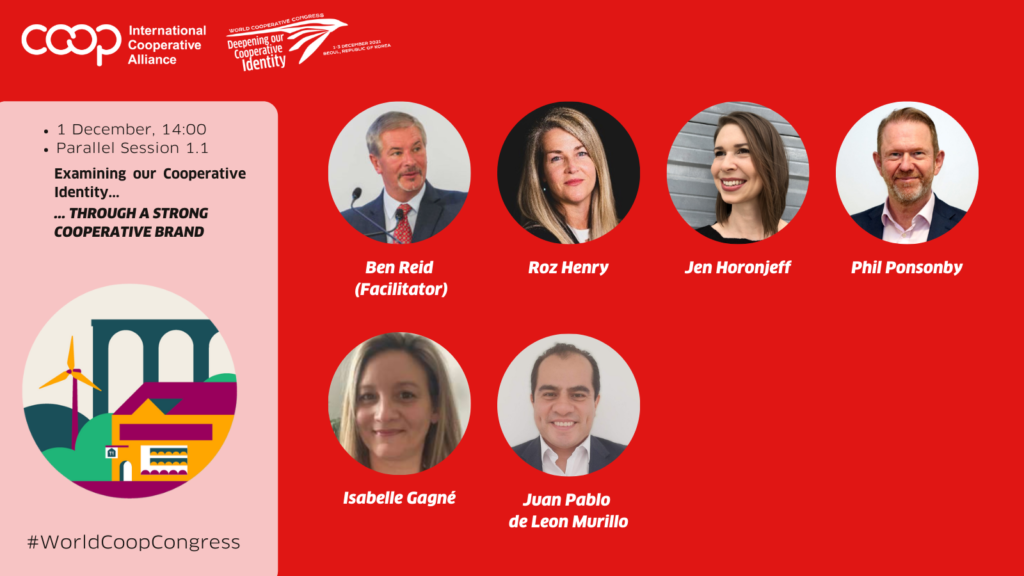
Delegates at the World Cooperative Congress heard from a group of international leaders in cooperatives and communications in a parallel session on the first day (1 December 2021).
Facilitated by Ben Reid OBE, the former CEO of Midcounties Cooperative and a board member of Dot.Coop and ICA Director (UK), the session looked at the importance of cooperative branding and how it can benefit organisations, their members, customers and communities.
Roz Henry, CEO of Cooperative Busines New Zealand, described how she developed the nz.coop brand, a cooperative promoting businesses in New Zealand through education, training, advocacy, lobbying, research and insights. Part of this was understanding the importance of establishing the size and the economic benefits of the whole cooperative sector.
“We commissioned the New Zealand Cooperative Economy Report from PricewaterhouseCoopers which was released in September,” she said. “It showed that New Zealand’s top 30 cooperatives had a joint revenue of NZ $42bn (US$29bn, €25bn, £21bn) in 2020 and accounted for 13% of New Zealand’s GDP. The report also showed that between them they had 1.5 million members and 41,000 members.”
Savvy is a new Cooperative in the US focussing on connecting healthcare professionals with patients and carers through a tech platform. Founder and CEO, Jen Horonjeff, described how “patients used to be people that healthcare professionals did things to rather than seeing them as partners”.
She set up Savvy to change this by channelling requests from their members, whether drug companies or researchers, directly to patients and carers. “Going through the vetting process and getting the dot.coop domain name was vital to gain the trust of the patients and the carers who are also owners of Savvy,’ she explained. “It also made a real difference to attracting the big pharmaceutical clients who were core to the business because they recognised that having cooperative values meant Savvy was a patient-centred platform.”
She believes that being a cooperative – and telling people about it – was very helpful in creating “a new type of cooperative in the tech space” and helped Savvy to become “the first healthcare sector cooperative to attract venture capital on non-traditional terms”.
In the UK, independent cooperative The Midcounties Cooperative recently undertook a rebranding exercise. The organisation operates seven businesses (broadband, childcare, energy, food, mobile, post offices and travel). CEO Phil Ponsonby explained that prior to 2016, most of the major cooperatives in the UK shared the same brand but then the Cooperative Group, the largest coop in the UK, had decided to unilaterally rebrand. As a result, the board of Midcounties “decided to adopt the ICA COOP mark, so that we could be part of the international cooperative movement”.
Mr Ponsonby said that he would “recommend this to other coops because it gives a quality mark of consistency in the brand, and reinforces that we are all part of a bigger movement”.
Midcounties has also recently added ‘your coop’ to the brand so that they could talk directly to their customers using new digital platforms; Midcounties now asks people to “join in, rather than just join us” in terms of all their involvement with the Society from standing for election to community engagement. Mr Ponsonby explained this is important because although Midcounties have 700,000 members, less than 5% of those trade with more than one of its businesses. “Adopting the new ‘your coop’ brand lets us have that conversation and encourage people to trade with different parts of the business – and it enables everyone to join in whether or not they are members.”
In Canada, the Quebec Council for Cooperatives and Mutuals, ran a national campaign to promote cooperative. Isabelle Gagne, Director of Communications, explained how she developed a consistent message and enabled them to stand out in the Canadian marketplace.
“The council put together a committee to do this, representing several different industries, particularly in the finance sector and then developed an online campaign called L’effet [‘The Effect’, www.effet.coop].
The campaign allowed cooperatives in Canada to promote their principles and how they were different, particularly those who didn’t have ‘cooperative’ in their name. The council then measured the results and found that 69% of people said they now understood coops better including what they did and how they were different.
Jean Pablo de Leon Murillo is Director of Communications at Caja Popular Mexicana (CPM), a credit union in Mexico with 3 million members
“We maximise the economic benefit for them by providing financial services at competitive and fair rates,” he said, adding that branding is much more than a cool logo – the brand needs to tell a story.
“We had developed cpm.coop to unify our identity and it is now used on over 4 million email accounts” which all promote the brand.
CPM recently celebrated its 70 anniversary with a national campaign. This involved creating a strong brand linked to members’ loyalty by using social media to its full potential. This has established a strong link with members and helped to introduce new services.
He believes there are five major benefits of being a strong cooperative brand: better member recognition; higher member loyalty; more word of mouth; higher applicant quality; higher employee motivation.
